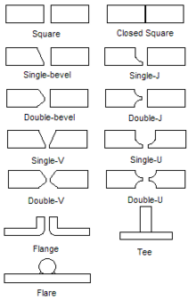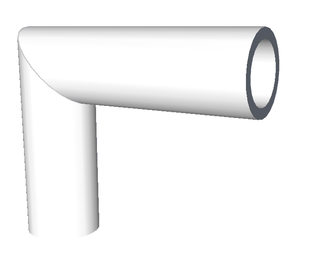Butt Welding is a frequently used technique in welding industries, both automated and manual methods of butt welding are very popular from decades.
A butt weld joins two metal surfaces lying edge to edge on the same plane against one another. In case of a gap in between the plates, the maximum allowable gap is 1/16 inch and finally, this gap is filled with a welding rod during the welding process.
Mainly Butt and Fillet welds are the two types of continuous welds, all other joints are the modification of these two types.

What is a Butt Weld?
Butt Weld is the most familiar, simplest and versatile form of joint used in fabrication industries and pipelines.
In Butt Weld, the two members do not overlap each other and their edges are nearly parallel to each other. Butt weld joint is done simply by placing two metal plates or components side by side on the same plane and weld metals remain along the joint, within the planes of the surfaces.
This method of welding is very common in industries like piping, automobile, energy, power etc.
Butt Joint Diagram
Butt Joints are widely used in fabrication industries and pipelines. Molten metal is applied in the outer circumference of the joint.
Different types of Butt welds are prepared depending on the thickness of the metal plates, groove and edge preparation are necessary before welding. In the figure below different types of Butt welds are shown, which will give a clear idea.

Butt Weld Symbol
Standard symbols are used within a drawing to guide the welders which in turn helps to get a better control over finished appearance and mechanical properties of welds.
The US standard symbols are outlined by the American National Standards Institute and the American Welding Society and are noted as “ANSI/AWS”. Welding symbols are most widely used in metal fabrication drawings.
Welding symbols are most widely used in metal fabrication drawings.
Butt Weld can be symbolized with the help of
1. An arrow line
2. A reference line
3. A dashed line
4. A symbol
The technical drawings for welds consist of an arrow, the arrow head always points towards the joint to be welded. This arrow comprises with letters, certain symbols and numbers which indicates design or pattern of the weld joint.

Butt Welding Process
Generally to butt joints are welded adopting methods like arc welding, resistance welding, high energy beam welding and even it is done by brazing for copper pieces.
MIG or TIG are mostly applied for Butt Welds as they can naturally join two pieces of metal together, different types of welding electrodes are used to enhances properties like corrosion resistance and strength.
The area which is melted during welding process is known as the faying surface, to increase the strength of the weld, the faying surface has to be shaped which is popularly known as edge preparation. Edge preparation is compulsory in most of the butt joint designs.
Edge preparation may be same or different for both the members of butt joint.
Butt Joint Uses
Simple, strong, durable, wide range of material coverage, smooth surface finish etc are the pros which make a butt weld more versatile.
One of the most common type of weld joints and observed in fabrication works and pipeline in industries. Butt joints are also used in automotive sectors, manual arc welding applications, power and energy sectors.
Butt Joint Advantages
Butt welds are preferred over another types of weld as it creates a strong weld and can be applied for various situations.
The advantages offer by Butt Welds are as follows:
- Butt welds can be performed over a wide range of materials like aluminum, steel, stainless steel, nickel alloys, titanium etc.
- It gives a strong and permanently sealed joint with complete fusion.
- We can get low cost pipe fittings with these welds.
- The welds have a smooth surface finish as the filler metal is deposited into the groove.
- Occupy a small space in a structure.
- It is possible to create multiple welds of different shape and size over the joint area.
- Inspection of butt welds is quite easy.
- Machining is simple and
- It provides distortion control.
- Less prone to dirt and pollutions.
Butt Joint Disadvantages
The advantages associated with Butt Joint are as follows:
- In case of thick metals, beveling of the joint edges is required for Butt welding.
- Burnthrough, Porosity, cracking and incomplete penetration are associated with these joints.
- Due to the welding geometry, applications can be limited.
- Due to the geometry of the welds, restrictions come in their applications.
- Difficult to weld thin sheet metal piece without filler metal.
- Sensitive towards faying surface conditions.
Types of Butt Joints
Butt Joints are made in different designs depending on width of the gap, thickness of the plates and they are used for different purposes.
Certain typical examples of Butt Joints are listed below:
- Square butt weld
- Single and double Bevel Butt Weld
- Single and Double V butt weld
- Single and Double U butt weld
- Single and double J Butt Weld
Square butt weld
This one is the simplest joint design, the thickness of metal pieces to be joined are 3/16 inch or less than that. On thin metal piece, a full penetration welds can be possible using square butt welds.
Though the square butt welds are quite strong they are not suitable for constant fatigue loads. The edges of two pieces do not need any modifications like beveling or chamfering.
Single and double Bevel Butt Weld
In case of thick metal pieces, it is difficult to get 100% penetration using butt welding, for this purposes certain type of groove preparation is required.
In single bevel design one piece remains as square and the other part is beveled to a specified angle.
Single and Double V Butt Weld
V welds cost more in preparation than square butt welds, it also consumes more filler material. Using cutting torch or beveling machine, the V groove is prepared. The main advantage is that V welds are stronger than square butt joint
The preparation time for double V is longer in comparison to single V. But use of filler metal is less as double V gives a narrower space.
Single and Double U butt weld
The preparation and welding cost of the U joint is the highest. The two pieces are prepared as a J groove and when they come together it gives a shapethe oa f U.
In double U joint , U shaped groove exists both on top and bottom of the joint, generally applied on thick base metals.
Single and double J Butt Weld
J groove is more difficult and costly to prepare than V groove, groove preparation is done by special machinery or grinding. Here one member is in J shape and the other one is square.
In double J, one piece is in J shape from both the ends and the other one is in square shape.
Mitered Butt Joint
The classic example of a mitered butt joint is a painting frame, consisting of four butt joints at each corner, all the four ends cut at a 45 degree angle.
A mitered butt joint is an union between two pieces cut at 45 degree at the corner and place next to one another to usually form an angle of 90 degree. It can and do vary at any angle greater than 0 degree and the joint meets at a sharp point. Picture frame, molding and pipes are the common examples.

It is a kind of easy wood working joint which generally gives a pretty look in picture and painting frames. They are not strong enough since they have no interlocking elements and depend only on wood glue.
Upset Butt Welding
Upset or Resistance Butt Welding is mainly used for nonferrous materials of smaller cross-sections like bars, rods, tubes, wires, etc.
This type of welding produces coalescence simultaneously along the joint, by the heat generated from electrical resistance through the area where the surfaces are in contact. Application of pressure is mandatory , heat application starts prior to heating and goes all throughout the process.
Upset welding is also observed in steel rails, closure of capsules, small containers etc.
Square butt weld
This one is the simplest joint design, the thickness of metal pieces to be joined are 3/16 inch or less than that.
Though the square butt welds are quite strong they are not suitable for constant fatigue loads. The edges of two pieces do not need any modifications like beveling or chamfering. On thin metal piece, a full penetration welds can be possible using square butt welds.
Butt vs Fillet Weld
Both of them are the most common continuous welds.
We can differentiate between Butt and Fillet welds as mentioned below:
| Butt | Fillet |
| The members to be welded are lying on the same level. | If the joining surfaces are perpendicular to each other, then they are joined with fillet welds. |
| Edge preparation is must in case of butt welds | Do not require any kind of edge preparation. |
| The joining surfaces are placed side by side or edge to edge. | Lap joint is also a type of fillet welds where two surfaces overlap each other. |
| Look wise weld can be resemble with seam or bead. | A 45 degree angle is formed between the two parts in case of fillet welds, filler metal is deposited in a triangular section at the joint. |
Butt weld vs Socket weld
Both Socket and Butt weld are quite popular.
We can differentiate between Butt and Socket welds as mentioned below:
| Butt | Socket |
| Here two pieces of pipes are kept in same plane and then welded. | In case of Socket weld two different diameter’s pipes are used and smaller one is inserted into the larger one. |
| For better penetration beveling is required. | Both the ends are square cut and no need of beveling or any preparation, other than surface cleaning. |
| Generally used for pipes having large diameters. | Mostly applied for small diameter pipes. |
| Pipes are connected by butt welding. | It gives a fillet weld. |
| X-ray inspection method is adopted for testing. | Non destructive testing methods like magnetic powder testing(MT) or Penetration Testing(PT)are adopted. |
| Highly resistant to corrosion. | Less corrosive resisteant. |
If we consider a small diameter pipe the cost of socket weld fitting is higher than butt weld fittings but butt welds are more expensive if we consider design, testing ,installation and maintenance. Socket joints are quite easy in terms of assembly, maintenance and installation making it less expensive than but welds.
In certain conditions Butt welds prove almost twice as much as stronger than socket welds.
.
Butt Welding Machine
An efficient Butt Joint machine should provide accurate welding pressure as well as a strong welding strength.
A Butt welding machine must possess a body with clamps, trimmer, heater, a removable electric facer, control unit, machine housing box and a set of inserts to adjust with different diameters of pipes.
The price of the welding machine varies as per the welding diameter of the product, for large weld diameter the cost of the welding machine is also high.
These machines vary in size between W160(power 220V -.55 KW) -W2800(power 380V -4KW).
Conclusion:
To wrap up our post we can state that Butt Welding is one of the most widely used welding process which results different types of Butt Welds with different specialties and they have to be selected carefully as per our requirement and budget.

I am Sangeeta Das. I have completed my Masters in Mechanical Engineering with specialization in I.C Engine and Automobiles. I have around ten years of experience encompassing industry and academia. My area of interest includes I.C. Engines, Aerodynamics and Fluid Mechanics. You can reach me at